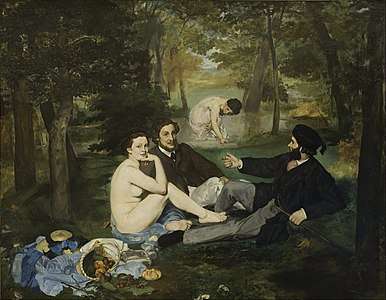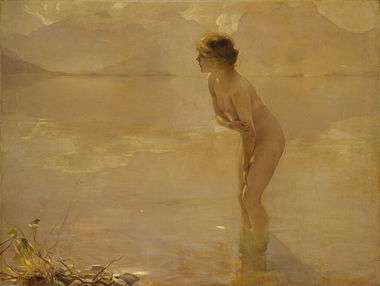Succès de scandale
Succès de scandale (French for "success from scandal") is a term for any artistic work whose success is attributed, in whole or in part, to public controversy surrounding the work. In some cases the controversy causes audiences to seek out the work for its titillating content, while in others it simply heightens public curiosity. This concept is echoed by the phrase, "there is no such thing as bad publicity".[1]



Belle Époque
The Belle Époque ('beautiful era') in Paris, roughly from 1871–1914, was notable for many succès de scandale. This was also where and when the term originated. In the examples below, artists started their careers with some sort of scandal, with some connection to turn-of-the-century Paris. In other cities, provoking a scandal appeared more risky, as Oscar Wilde found out shortly after his relatively "successful" Parisian scandal (Salomé in 1894, portraying the main character as a necrophile).
- Le déjeuner sur l'herbe ("Luncheon on the Grass") by Édouard Manet,[2] presented at the Salon des refusés, 1863: Even the Emperor was scandalised — but Manet had a nice start to his career.
- Alfred Jarry shocked Paris in 1896 with the first of his absurdistic Ubu plays: Ubu Roi. The performance of this play was forbidden after the first night, though Jarry got around the prohibition by moving the production to a puppet theatre.
- A new group of artists, labeled disrespectfully "Les Fauves" ("The Wild Beasts") by an art critic, had their successful debut in 1905 Paris (and kept the name).
- Richard Strauss had little success with his first two operas, which today are no longer performed. He then tried something different: he set music to Wilde's Salomé in 1905. It created a scandal, including in the New York Met, where the production had to be closed after one night. But Strauss wanted more, and his next opera, (Elektra, 1909) was so "noisy" that cartoons appeared with Strauss directing an orchestra of animals. However, the opera's libretto, written by Hugo von Hofmannsthal, was quite tame.
- The 1912 ballet Afternoon of a Faun, choreographed and headed by Vaslav Nijinsky, provoked strong reactions. The newspaper Le Figaro wrote in a front-page review that the "movements are filthy and bestial in their eroticism".[3] Despite, or because of, this criticism, the ballet was sold-out in Paris.
- The Rite of Spring (1913)[4]
- The original 1917 production of the ballet Parade.
- George Antheil's 1923 performance of futurist piano music at the Champs-Élysées theater.[5]
- Paul Chabas had won a most prestigious prize with his September Morn in Paris in 1912. Nudity as portrayed in this painting was, however, far from shocking to Parisians half a century after Déjeuner. The market value of the painting remained low. Then, Chabas put it on display in a New York shop window in 1913. There, for the first time in history, it appears a succès de scandale scheme was set up by a publicity agent (Harry Reichenbach), who "accidentally" tipped off a morality crusader to the picture. The scandal that evolved brought financial success and secured Chabas's place in art history books. Although later deemed kitsch, the painting ended up in one of the most prestigious museums of New York.
Other examples
This was not the last time that Comstockery fanned the success it wanted to prohibit: "I expect it will be the making of me" said Mae West to the press in 1927, under arrest after the Society for the Suppression of Vice had maneuvered to get her play titled "Sex" re-censored by the Police Department Play Jury. A few years later, when she was over 40 years old, her sex-symbol status paid off when her 1935 film contract made her the highest-paid woman to date.
Films qualified as succès de scandale include Louis Malle's 1958 The Lovers,[6] and Bernardo Bertolucci's 1972 Last Tango in Paris.[7] Scandal also boosted the success of writers of modest talent.[8] Even famous writers like Flaubert and Joyce have been described as deploying succès de scandale recipes to their advantage.[9]
See also
References
- Martin, Gary. "'There is no such thing as bad publicity' - the meaning and origin of this phrase". Phrasefinder.
- Clare Brook. "Why BLUE needs a Succès de Scandale" at www
.bluemarinefoundation .com - Le Figaro, 30 May 1912, "Un Faux Pas" Gaston Calmette editorial, cited in Buckle, Nijinsky, p.242. Buckle suggests Calmette was seeking to imply Nijinsky was showing bulging genitalia when seen in profile.
- Richard Taruskin. Stravinsky and the Russian Traditions: A Biography of the Works Through Mavra, p. 1008 University of California Press, 1996. ISBN 0520070992 ISBN 9780520070998
- Whitesitt, Linda. "Antheil, George". Grove Music Online. Oxford Music Online. Retrieved 3 December 2011.
- Ginette Vincendeau. "The Lovers: Succès de scandale" at www
.criterion .com - Patrick Duynslaegher. "Last Tango in Paris: Succès de scandale" in Knack, 31 January 2011.
- Isabelle de Courtivron. "The French Still Love a Succes de Scandale" in The New York Times. June 22, 1997
- Valérie Bénéjam. "The Elliptical Adultery of Ulysses: A Flaubertian Recipe for Succès de Scandale", pp. 76–93 in James Joyce and the Nineteenth-Century French Novel edited by Finn Fordham and Rita Sakr. Rodopi, 2011. ISBN 9042032901 ISBN 9789042032903